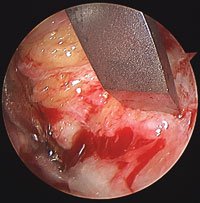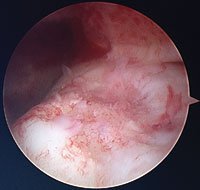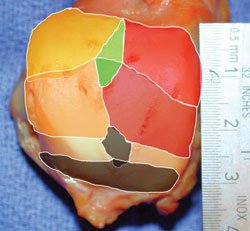Plafondplasty may provide easier access to osteochondral lesions of the talus
KEYSTONE, Colo. – Limited plafondplasty may provide enough exposure to access talar dome osteochondral lesions and may eliminate the need for osteotomy, according to a recent presentation at the 2011 Annual Meeting of the American Orthopaedic Foot and Ankle Society.
Osteochondral allograft or autograft transplants (OATs) require the orthopedist to cut through the tibia or fibula at a perpendicular angle to reach the talus, according to study author Lew C. Schon, MD. Complications from OATs procedures may include delayed union, nonunion or malunion from the osteotomy, pain due to the hardware to fix the osteotomy or donor site morbidity, he said.
“I did the OATs procedure for failed drilling or curettage of osteochondral lesions and we were very careful and I think we had very nice results, but we had some close calls and we had cases where we had to go back in and bone graft or take out hardware,” Schon said. “I’ve seen patients done elsewhere where they had malunions and we had to reosteotomize and the arthritis got worse.”
|
|
Images: Schon LC |
Tibial plafondplasty
With a plafondplasty, Schon said, the orthopedists no longer have to access the lesion at a perpendicular angle because there is no need for an osteotomy.
“I decided to look at the tibial plafondplasty to see how much access we can get to the talus in a nonperpendicular exposure, and we designed a study to answer that question,” Schon said.
Accessible surface area
|
|
Schon and his team conducted their study using 12 cadaveric lower extremities to find out the accessible surface area and sagital plane access compared with medial and lateral soft tissue exposures. The specimens had an average age of 59.6 years, and there were four bilateral specimens.
The team found that the medial and lateral soft tissue exposures had a 22.3% and 22.4% access to the body surface area and 54.3% and 53.3% sagittal plane access. Limited plafondplasty fared better with medial access at 37.9% and lateral at 37.9% for total surface area and 81.6% medial and 80.9% lateral for sagittal plan access. An additional 14% could be reached from the front, but “it was trickier,” Schon said.
Approximately 10% was inaccessible and must be accessed from the back, he noted.
The technique
For the plafondplasties in their study, the team removed a 1-cm wide, 1-cm high, 8-mm deep block of bone from the tibia at a 45° angle. In the operating room, Schon says he removes as much bone as needed.
“Since I started doing the particulated juvenile cartilage grafts, I’ve not had to do any osteotomies,” Schon said. “I’ve personally done 25 or 30 plafondplasties with juvenile cartilage grafts. At our site, we may be close to 50. I have done no osteotomies because I’m confident I can get to where I need to.” – by Renee Blisard
Reference:
- Peters P, Parks BG, Schon L. Distal tibia plafondplasty for talar dome osteochondral lesion exposure. Paper #6. Presented at the 2011 Annual Meeting of the American Orthopaedic Foot and Ankle Society. July 13-16. Keystone, Colo.

- Lew C. Schon, MD, can be reached at Greater Chesapeake Orthopaedic Associates, 3333 N. Calvert St., Suite 400, Baltimore, MD 21218; 410-554-2270; email: lewschon@comcast.net.
- Disclosure: Schon is a consultant to Zimmer.
The incidence of osteochondral lesions of the talus is high and treatment remains challenging. With larger lesions, or if prior operations have failed, additional procedures involving autograft or allograft are considered. Exposure of the talus for grafting can be difficult. Several factors including the size, depth and location of the lesion, as well as the viability of articular cartilage, help determine the surgical approach.
Peters et al presented a cadaveric study of 12 specimens utilizing anteromedial and anterolateral exposures with limited anterior distal tibial plafondplasties. They found that the plafondplasties significantly increased the total accessible surface area. The posterior 10% of the talar body was not easily reached with this technique alone.
Historically, grafting procedures required that the lesion be fully visible, and the graft be inserted perpendicularly. More modern chondrocyte repair techniques do not require perpendicular insertion. Furthermore, osteotomies carry risks such as nonunion and articular cartilage injury. Arthroscopy will help determine the size, location and approach to the lesion.
This study shows that limited tibial plafondplasty provides adequate exposure for most talar lesions. Osteotomies should be reserved for larger lesions and for those involving the posterior 10% of the talar body.
— Craig S. Radnay, MD
Insall Scott Kelly
Institute for Orthopedics and Sports Medicine
New York City
Disclosure: Radnay is a consultant for Smith & Nephew and Wright
Medical, and on the speakers’ panel for Ortho McNeil Janssen.












